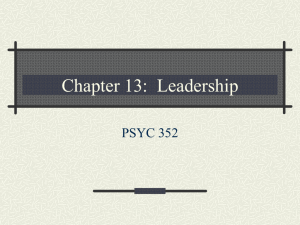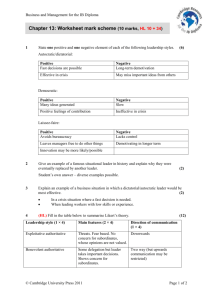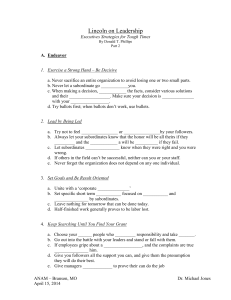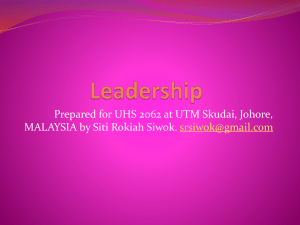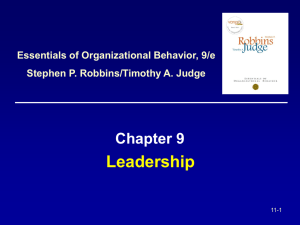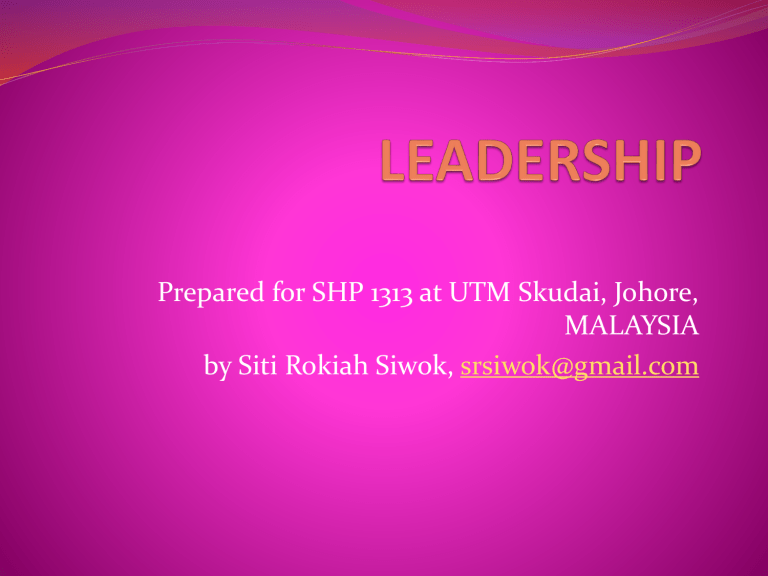
Prepared for SHP 1313 at UTM Skudai, Johore,
MALAYSIA
by Siti Rokiah Siwok, srsiwok@gmail.com
First , a basic question:
Is study of leadership important?
Leadership
What is leadership?
Who are leaders?
What do they do?
What are their characteristics?
Any difference between effective leaders and
ineffective leaders?
Do they have similar/different styles of leadership?
Etc
An overview
Define what leadership is.
Identify traits of effective leaders.
Describe behaviors that effective leaders
demonstrate.
Explain the concepts of contingency ,
transactional, transformational, and charismatic
leadership.
Specify the contexts in which various leadership
styles are effective
Develop your own leadership skills.
What is leadership?
What is Leadership?
Leadership is the ability to guide a group
toward the achievement of goals.
Leaders can be formally recognized by the
organization, or individuals can emerge as
informal leaders within work groups
because they have some characteristic that
the group members value.
Leader and Leadership
Leadership is an influence process that includes
any behavior that helps clarify a group’s purpose or
guides the group to achieve its goals.
A leader is a person who is assigned or selected, or
emerges from a group, to guide or provide
direction towards reaching the group’s goal ( Sieler
and Beall, 2011 page 431)
7
Leadership
Many questions are being asked related
to leadership, such as:
Are leaders born?
Are leaders “bred”/developed?
Leader emergence
It is the idea that people who become
leader have traits or characteristics
different from people who do not
become leaders.
Universalist Theories of
Leadership
Universalist theories look for the major
characteristics common to all effective
leaders.
Great man/woman theory maintains that
great leaders are born, not made.
2. Trait theory attempts to discover the traits
shared by all effective leaders.
1.
Traits are enduring attributes associated with
an individual’s personality or makeup.
(Riggio, 2009)
Universalist Theories of Leadership
Research indicates that extraversion,
conscientiousness, openness to experience,
agreeableness, and emotional stability, in
combination, are associated with effective
leadership (Bono and Judge, 2004 in Riggio
2009).
Possession of flexibility, charisma, and social
intelligence are also important for leadership
(Riggio, 1986).
The major problem with the original trait
approach is that it was too general.
Characteristics of Leaders
Leaders have special characteristics .
Recent reviews show that :
People high in openness, conscientiousness,
extraversion and low in neuroticism are more likely to
emerge as leaders (Judge, Bono, Ilies and Gerhardt, 2002
in Aamodt 2010)
High self monitors emerge as leaders more often then
low self-monitors.
More intelligent
Characteristics of Leaders
Meta-analysis by Youngjohn (1999) found that
individual-difference variables were good predictors of
leadership performance:
Charismatic
Dominant
Energetic
High in self monitoring
Summary of Leadership Characteristics:
Leader Emergence
Traits
Intelligence
Openness to experience
Extraversion
Conscientiousness
Emotional stability
High self-monitoring
Leadership emergence seems
to be stable across the life-
span
14
Traits and leadership: BIG 5
Personality Traits
Traits and leadership: Intelligence
General mental ability, which psychologists refer to as
“g” and which is often called IQ in everyday language,
has been related to a person’s emerging as a leader
within a group. Specifically, people who have high
mental abilities are more likely to be viewed as leaders
in their environment
We should caution, though, that intelligence is a
positive but modest predictor of leadership.
Leadership and EQ
In addition to having high IQ, effective leaders tend to
have high emotional intelligence (EQ)
People with high EQ demonstrate a high level of selfawareness, motivation, empathy, and social skills.
According to Goleman ( 1995), what differentiates
effective leaders from ineffective ones becomes their
ability to control their own emotions and understand
other people’s emotions, their internal motivation, and
their social skills
Emotional intelligence
Goleman (1995) identified the five 'domains' of EQ
as:
1.
2.
3.
4.
5.
18
Knowing your emotions.
Managing your own emotions.
Motivating yourself.
Recognising and understanding other people's
emotions.
Managing relationships
Looking at what leaders do
Leader Performance/Behaviour
Leader performance involves the idea that people
who perform well have certain characteristics that
poor performing leaders do not.
Rather then thinking that a leader “emerge”, we
can look into the performance of the leaders. We
see what are the characteristics of leaders who
perform well vis-à-vis those not performing well.
Behavioral Theories of
Leadership
Behavioral leadership theories (derived from Ohio
State and University of Michigan studies) focus on the
behaviors common to effective leaders.
The Ohio State Leadership Studies identified two
important leader behaviors:
Initiating structure (defining, organizing, structuring
the work situation).
Consideration (showing concern for feelings and needs
of followers).
Behavioral Theories of Leadership
The University of Michigan Leadership
Studies also identified two important leader
behaviors.
In task-orientated behaviors, leader
behaviors focused on the work task.
In relationship-oriented behaviors,
leader behaviors focused on maintaining
interpersonal relationships on the job.
Both types of behaviors have been linked to
effective leadership.
Task Versus Person Orientation
Person-Oriented Leaders
act in a warm, supportive manner and show
concern for the employees
believe employees are intrinsically motivated
Task-Oriented Leaders
set goals and give orders
believe employees are lazy and extrinsically
motivated
23
Task oriented leaders
Task-oriented leaders see their employees as lazy ,
extrinsically motivated, undisciplined etc, so task-
oriented leaders lead by giving directives, setting
goals and making decision without consulting
their subordinates.
Included in the task oriented leaders are :
Task-centred leaders
Theory X leaders
High initiating structure
Person oriented leaders
Act in a warm, supportive manner and show
concern for the employees
believe employees are intrinsically motivated
Consequences of Leader’s
Orientation
High Person Low performance High performance
Orientation Low turnover
Low turnover
Few grievances
Few grievances
Low Person
Orientation
Low performance High performance
High turnover
High turnover
Many grievances Many grievances
Low Task
Orientation
High Task
Orientation
26
Instruments
The orientation of a leader can be measured by several
instruments such as:
Leadership Opinion Questionnaire ( LOQ)
Leader Behaviour Description Questionnaire (LBDQ)
Unsuccessful Leaders
(Hogan, 1989)
Lack of training
Cognitive deficiencies
Personality problems
paranoid/passive-aggressive
high likeability floater
narcissist
28
Unsuccessful Leader Behaviors
Shen et al. (2008)
Engaging in illegal and unethical behavior
Avoiding conflict and people problems
Demonstrating poor emotional control (e.g., yelling
and screaming)
Over-controlling (e.g., micromanaging)
Demonstrating poor task performance
Poor planning, organization, and communication
Starting or passing on rumors or sharing confidential
information
Procrastinating and not meeting time commitments
Failing to accommodate the personal needs of
subordinates
Failing to nurture and manage talent
29
Leadership and Situation
Interaction between leader and
situation
Leader’s effectiveness not only depends on traits that
s/he posses but also on the particular situation in
which the leader is in.
Several theories ( or models) have emerged to explain
the situational nature of leadership.
Interaction Between the Leader
and the Situation
Situational Favorability
Organizational Climate
Subordinate Ability
Relationships with
Subordinates
32
Leader and situation: Fiedler’s
Contingency Model
Fiedler’s contingency model holds that any leader is
effective only in certain situations.
Thus Fiedler argue that rather than change the leadership
style , leadership training should concentrate on helping
people understand their leadership style and manipulate
the environment to make a perfect match.
Fiedler developed Least Preferred coworker scale
( LPC)
Fiedler’s ideas supported by researches
Fiedler’s training : Leader match
LPC
The least-preferred coworker (LPC) scale
classifies leadership styles.
Describe the one person with whom he or she
worked the least well with.
From a scale of 1 through 8, describe this person
on a series of bipolar scales:
Unfriendly 1 2 3 4 5 6 7 8 Friendly
Uncooperative 1 2 3 4 5 6 7 8 Cooperative
Hostile 1 2 3 4 5 6 7 8 Supportive
Guarded 1 2 3 4 5 6 7 8 Open
35
Relationship Between LPC Scores and Group
Success
High LPC
Score
Low
Performance
High
Performance
Low Performance
Low LPC
Score
High
Performance
Low
Performance
High
Performance
Low
Moderate
High
Situation Favorability
36
Fielder’s Contingency Model:
Implications
The favorableness of leadership situations should
be assessed.
Candidates for leadership positions should be
evaluated using the LPC scale .
If a leader is being sought for a particular
leadership position, a leader with the appropriate
LPC profile should be chosen.
If a leadership situation is being chosen for a
particular candidate, a situation should be chosen
which matches his/her LPC profile.
38
Applying Fiedler’s Contingency
Theory
Fill out the LPC
Determine whether you are task or relationship
oriented.
Think of a leadership situation in which you were not
optimally effective and/or one in which you excelled
Evaluate the situation(s)
Does your experience support Fiedler’s theory?
Contingency theory: Strengths
Supported by a lot of empirical research
Looks at the impact of the situation on leaders
It is predictive
It does not require that people be effective in all
situations
It provides a way to assess leader style that could be
useful to an organization
40
Contingency Theory: Weaknesses
There is some doubt whether the LPC is a true
measure of leadership style
It is cumbersome to use
Doesn't explain what to do when there is a mismatch
between style and situation
Other situational variables, like training and
experience, have an impact in a leader's effectiveness
41
Leader and situation: IMPACT
Theory
Leader and situation: IMPACT
IMPACT theory, developed by Geier,
Downey and Johnson (1980).
Leaders have 6 behaviour styles : informational,
magnetic, position, affiliation, coercive and
tactical.
Each style is effective with only one particular
situation or organizational climate.
IMPACT THEORY
Informational style in climate of ignorance
Magnetic style in a climate of despair
Position style in a climate of instability
Affiliation style in a climate of anxiety
Coercive style in a climate of crisis
Tactical style in a climate of disorganization
IMPACT THEORY: STRATEGIES
Find a climate consistent with your
leadership style
Change your leadership style to better fit the
climate
Change your followers perception of the
climate
Change the actual climate
Leader and situation: Path-goal
Theory
Leaders who can adapt their behaviour to match the
needs of their subordinates will be more effective
than leaders who stick to one leadership style ( Foster,
1999, in Aamodt, 2010)
According to the path-goal theory ( House, 1971, in
Aamodt, 2010), a leader can adopt one of the
leadership styles to manage different situations:
Instrumental/Directive
Supportive
Participative
Achievement -oriented
Path-goal Theory
Each style will work in certain situations and also
depends on the subordinates’ abilities and the extent
the task is structured.
The higher the level of subordinates’ abilities, the less
directive the leader should be.
On the contrary, the less structured the situation , the
more directive will the leader be ( Schriesheim and
DeNisi, 1981 in Aamodt 2010)
Path-goal Theory
In addition, according to this theory, a leader should:
Recognize the needs of subordinates and work to satisfy
those needs.
Reward subordinates who reach their goals.
Help subordinates identify the best paths to take in
reaching particular goals.
Clear those paths so that employees can reach their
goals.
As path-goal theory is behaviour based, the
theory could be used in training.
Path-Goal Theory
Path-Goal Theory: Leadership
Behaviours
Directive leadership – leader gives instructions,
expectations, time lines, and performance standards
Supportive Leadership- leader is friendly and
approachable, attends to the well being of subordinates,
and treats everyone as equals
Participative Leadership- leader invites subordinates to
give ideas, share opinions and integrates their suggestions
into the decision making process
Achievement-Oriented Leadership- leader challenges
subordinates to perform at the highest level possible.
Leader has high standards of excellence and seeks
continuous improvement.
Path-Goal Theory:
Subordinate Characteristics
Need for affiliation- prefer supportive leadership
Preferences for structure – prefer directive leadership
Desires of control- prefer participative leadership
Self-perceived level of task ability- prefer
achievement orientated leadership
Path-Goal Theory
Pros
Helps understand how leader behavior effects
subordinates satisfaction and work performance
Deals directly with motivation – one of the only
theories to address this
Provides a very practical model – make a clear path
and follow it
Path-Goal Theory
Cons
This is a very complex theory that incorporates many
aspects of leadership.
Research only partially supports the theory.
Fails to explain adequately the relationship between
leader behavior and subordinate motivation
Treats leadership as a one way street, places a majority
of the responsibility on the leader.
Situational leadership: Hersey
and Blanchard (1988)
Leader and situation: Situational
leadership theory
Developed by Hersey and Blanchard (1988), a
leader uses four leadership styles :
Delegating
Directing
Supporting
Coaching
Situational leadership: Hersey and
Blanchard (1988)
Leader and situation: LMX (VDL)
Leader and situation: LMX (VDL)
LMX is another leadership theory and was originally
called vertical dyad linkage ( VDL) theory.
The uniqueness of this theory is the focus on
interaction between ,leaders and subordinates.
These interactions are called leader-member
exchanges ( LMX).
The idea originates from the relationship between two
people( dyad) whereby the leader is in the position
above the subordinate ( vertical) plus their interrelated
behaviours ( linkage). Hence VDL.
Relationships with Subordinates
Leader-Member Exchange (LMX) Theory
Concentrates on the interactions between
leaders and subordinates
Subordinates fall into either the:
in-group
out-group
In-group employees
More satisfied
Higher performance
Less likely to leave
60
Leader-Member Exchange (LMX)
Theory
The leader-member exchange model asserts that
effective leadership is determined by the quality of the
interaction between leaders and particular group
members.
Leader-member exchange can range from low quality to
high quality.
With high quality leader-member exchange, there is
frequent, positive communication between leaders and
members.
Other Leadership Styles
62
Charismatic Leadership Theory
Charismatic leadership theory states that
leaders possess some exceptional
characteristics that cause followers to be loyal
and inspired.
Charismatic leaders communicate shared
group goals and convey confidence in their
own abilities and those of followers.
Charismatic leaders are most effective when
goals are unclear and situational conditions are
unstable.
Some researchers suggest that charismatic
leaders possess exceptionally high-quality
social skills and an ability to inspire followers
at a deep emotional level (Riggio, 1987).
Charismatic Leadership: Key
Characteristics
Self Confidence- They have complete confidence in their
judgment and ability.
A vision- This is an idealized goal that proposes a future
better than the status quo. The greater the disparity between
idealized goal and the status quo, the more likely that
followers will attribute extraordinary vision to the leader.
Ability to articulate the vision- They are able to clarify and
state the vision in terms that are understandable to others.
This articulation demonstrates an understanding of the
followers’ needs and, hence acts as a motivating force.
Charismatic Leadership: Key
Characteristics
Strong convictions about vision- Charismatic leaders
are perceived as being strongly committed, and willing
to take on high personal risk, incur high costs, and
engage in self-sacrifice to achieve their vision.
Behavior that is out of the ordinary- Those with
charisma engage in behavior that is perceived as being
novel, unconventional, and counter to norms. When
successful , these behaviors evoke surprise and
admiration in followers.
Charismatic Leadership: Key
Characteristics
Perceived as being a change agent- Charismatic
leaders are perceived as agents of radical change rather
than as caretakers of the status quo.
Environmental sensitivity- These leaders are able to
make realistic assessments of the environmental
constraints and resources needed to bring about change.
What it means to be a leader:
Specific Leader Skills
Leadership Through Decision
Making
Vroom-Yetton
Model
68
Leadership Through Contact
Management by
walking around
69
Leadership Through Power
Expert Power
Legitimate Power
Reward Power
Coercive Power
Referent Power
70
Leadership Styles, Behaviour and
Power
Leadership can also be classified according to the
extent power is given to the group members.
Theoretically, there are three different styles:
1.
2.
3.
Autocratic: Keep control
Democratic: Share control
Laissez-Faire: Give up control
Autocratic
Leader makes decisions without reference to
anyone else
High degree of dependency on the leader
Can create de-motivation and alienation
of staff
May be valuable in some types of business where
decisions need to be made quickly and
decisively
Democratic
Encourages decision making
from different perspectives – leadership may be
emphasised throughout
the organisation
Consultative: process of consultation before decisions
are taken
Persuasive: Leader takes decision and seeks to persuade
others that the decision
is correct
Democratic
May help motivation and involvement
Workers feel ownership of the firm and its ideas
Improves the sharing of ideas
and experiences within the business
Can delay decision making
Laissez-Faire
‘Let it be’ – the leadership responsibilities
are shared by all
Can be very useful in businesses
where creative ideas are important
Can be highly motivational,
as people have control over their working life
Can make coordination and decision making
time-consuming and lacking in overall direction
Relies on good team work
Relies on good interpersonal relations
Types of Leadership Style:
Paternalistic
Leader acts as a ‘father figure’
Paternalistic leader makes decision but may
consult.
Believes in the need to support staff.
Leadership Through Vision
Transformational Leadership
Visionary
Charismatic
Inspirational
Challenge the status-quo
Carefully analyze
problems
Confident and optimistic
77
Transformational Leadership
Transformational leadership focuses on
the leader’s ability to provide shared values
and a vision for the future of the work group.
There are four components of transformational
leadership.
Idealized influence: the transformational leader is
a positive role model.
Inspirational motivation: the leader inspires
followers by providing a compelling vision of a
positive future.
Intellectual stimulation: followers’ curiosity and
creativity are stimulated and challenged.
Individualized consideration: the leader pays
personal attention to each member’s needs and
concerns.
Transactional vs Transformational
leaders
Transactional Leaders
Contingent Reward: Contracts exchange of rewards for effort,
promises rewards for good performance, recognizes
accomplishment
Management by exception (active): Watches and searches for
deviations from rules and standards, takes corrective action.
Management by exception (passive): Intervenes only if
standards are not met
Laissez faire: Abdicates responsibilities, avoids making
decisions
Transactional vs Transformational
leaders
Transformational Leaders
Charisma : Provides vision and sense of mission, instills
pride, gains respect trust.
Inspiration: Communicates high expectations, uses
symbols to focus efforts, expresses important purposes in
simple ways.
Intellectual Stimulations: Promotes intelligence,
rationality, and careful problem solving.
Individualized consideration: Gives personal attention,
treats each employee individually, coaches, advises.
Summary of leadership theories
Theory
Components
Model type
Great man-great women
theory
Effective leaders are born, Descriptive
not made
Trait theory
Common traits to all
effective leaders
Descriptive
Theory X , theory Y
Two types of leaders:
traditional and nontraditional
Descriptive
Fiedler’s Contingency
theory
Leader must be matched
to situational
characteristics
Predictive
Path –goal theory
Leader must play roles to
help groups attain goals
Descriptive-predictive
Summary of leadership theories
Theory
Vroom –Yetton Decision
Making Model
Components
Model
type
Leader asks situation-related
questions before choosing
decision-making style
Prescriptive
Leader-member exchange Focuses on quality of leadermember relationship
Descriptivepredictive
Transformational
leadership
Leaders inspire and provides
“vision” for followers
Descriptive
Charismatic leadership
Followers drawn to exceptional
characteristics possessed by
leader
Descriptive
Applications of Leadership
Theories
Leadership training can follow two general
approaches.
Teaching leaders diagnostic skills for assessing
situations to determine types of leader
behaviors that work best.
Teaching leaders specific skills or behaviors
that they lack.
A combination of both approaches is likely to
be most effective.
Please read more…
and it will get more interesting…..
References
Aamodt, M.G (2010). Industrial and organizational
psychology. An applied approach (6th ed) Belmont, CA:
Wadsworth
Riggio, R. E. ( 2009). Introduction to
Industrial/Organizational Psychology (5th ed). New Jersey:
Pearson/Prentice Hall.
Northouse, P.G. (2007) Leadership Theory and Practice.
Sage Publications, Inc. Thousand Oaks, CA.
http://www.flatworldknowledge.com
http://psychology.about.com/od/theoriesofpersonality/a/t
rait-theory.htm


